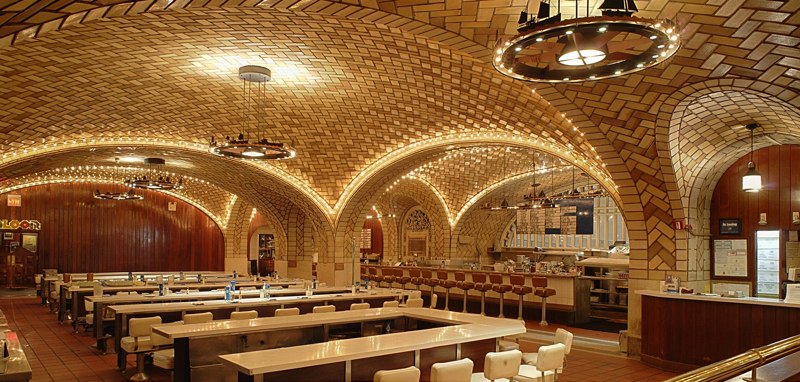by Camila Schaulson Frenz
On the evening of 03.25.14, the celebration of Catalan architecture in the city continued with the Museum of the City of New York’s (MCNY) tremendously well-attended exhibition opening for “Palaces for the People: Guastavino and the Art of Structural Tile.”
If you enter a Beaux Arts building constructed between 1881 and 1962 and look up, there is a good chance that you will see a tiled, herringbone-patterned vault designed by the Guastavino Fireproof Construction Company. Guastavino resides in the subconscious of New Yorkers, but his name often goes unnoticed, over-shadowed by the famous firms that commissioned his work.
The exhibition was originally organized by MIT with contributions from the Boston Public Library and the National Building Museum. In New York, the exhibition has been expanded to focus on how Guastavino tile construction shaped the architectural history of New York in the late 19th and early 20th century.
The Guastavino Company was extremely prolific, responsible for more than 1,000 commissions around the United States, with more than 250 in New York City alone. What is more, curator John Ochsendorf, MacArthur Fellow and Professor of Civil and Environmental Engineering and Architecture at MIT, stated that the MIT-based Guastavino Project, dedicated to documenting and preserving the tile vaulted works by the Guastavinos, discovers about one new project every week.
“Palaces for the People” is meant to shed light on an immigrant father-and-son team that helped build some of the nation’s most iconic structures. In 1881, Guastavino Sr. sailed from Barcelona to New York with his small son, bringing with him an ancient Mediterranean building technique – the Catalan vault.
Lightweight, low-maintenance, and capable of withstanding incredible weight, Guastavino innovated upon the original Spanish building method of layering thin tiles by introducing a fast-setting cement. During an exclusive morning tour for AIA members on the morning of the opening, MCNY Curatorial Associate Sarah Spink explained that his patented technique allowed workers to stand on the tiles that had been set only the day before. The exhibition, designed by C&G Partners, includes wall-sized historical photographs of the construction process, one of which shows Guastavino Sr. standing on a half-built vault.
To Ochsendorf, the allure of the Guastavino vault resides in its ability to bring together craftwork and masonry with architecture and engineering. Although the Guastavinos’ methods more closely resembled those of Gothic master builders, the vaults are feats of engineering. Spink noted that students working with Ochsendorf at MIT marvel at the Guastavino projects, oftentimes so complicated that the latest computer modeling software contend against reality, claiming that his projects shouldn’t even stand. “Palaces of the People” highlights this quality by presenting a half-scale replica of the Boston Public Library vault, created by MIT students along with a team of builders and craftsmen. A video of the construction process further illuminates the complexities of building like Guastavino.
The engineering mastery of the vaults also creates soaring interior public spaces. At the far end of the main exhibition space, visible as soon as you enter the exhibition, is a monumental photograph of the abandoned but beautifully preserved City Hall Station, nicknamed “the Mona Lisa of subway stations” by Spink. A number of detailed technical drawings, on loan from Columbia’s Avery Library, are also on view, including a beautiful watercolor detail of the Vanderbilt Hotel. Additionally, “Palaces for the People” facilitates the architectural experience of inhabiting a Guastavino space through an interactive video that allows you to enter and move through a number of the company’s commissions, including the Bronx Zoo Elephant House, which also offers views of a few furry friends!
Luckily, it appears as though the Guastavinos are finally receiving the recognition they justly deserve. “It felt like Justin Timberlake was in the building,” said EY Zipris, MCNY manager of program and professional development, of the exhibition’s opening night. “People were saying ‘Guastavino! Guastavino is here!’”


